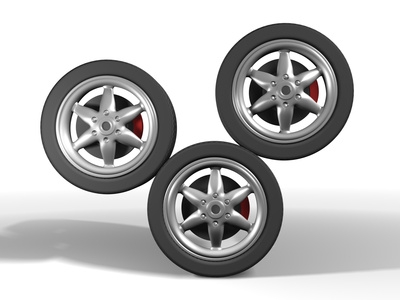
There are three types of tires designed to suit different weather conditions. For those living in climates that rarely drop below freezing temperatures, all-season tires are suitable. In colder areas where temperatures regularly drop below freezing, snow and ice create dangerous driving conditions and snow tires become necessary. A newer grade called all-weather-plus is manufactured by Nokian, a popular tire manufacturer.
When comparing all-season tires versus snow tires, the most important factors are handling and braking distances in snowy weather conditions. Under these conditions it becomes obvious why snow tires are an excellent choice in colder climates. Snow tires can deliver traction that is 25 to 50 percent better than all-season tires. On snowy roads, snow tires are able to bring the car safely to a stop. All-season tires under the same conditions can take up to 42 percent more distance than a snow tire to bring the car to a stop.
Snow tires and all-weather tires are made from softer compounds than all-season tires. Soft stud and tread fibers are built into the tire. These fibers grip the road without the problems that metal studs cause. These compounds remain flexible in cold climates and this allows for greater traction and control. Snow and all-weather tires are generally made from silica and micro pore compounds. All-season tires are composed of denser compounds that harden under 45 degrees Fahrenheit. No soft studded material is present in all-season tires because they are designed to wear less quickly than snow tires and all-weather tires.
The treading in snow and all-weather tires is designed to expel water, slush and snow more effectively than with all-season tires. Snow and all-weather tires are made with wider circumferential grooves that create channels to expel water and snow. Siping, or small slits on the tread surface, help the tire make better contact with the road. All-season tires are designed with less aggressive treading that allows for more comfort driving on the highway. All-season tires are made with less siping.
The Rubber Manufacturers Association is the national trade organization for the elastomer products industry. There are two groups, one of which is the tire group and consists of manufacturers who produce tires. The RMA specifies standards for tires that makes it easier for consumers to select a tire to suit their needs. M+S tires provide some traction in mud and snow. The RMA also has another standard called the Severe Winter Traction Standard and any tires stamped with the logo, a mountain with a snowflake inside it, provide superior traction to the M+S tires in snowy conditions.
Nokian Tyres, a tire manufacturer based in Finland, produces the world's only line of all-weather-plus tires. These tires can be driven year round in snowy and dry conditions. It was originally manufactured for year round driving for consumers in Finland. As of 2010, Nokian has two tires in this line: the WRG2 and WR. The WRG2 is made of a canola-silica compound while the WR is composed of high-dispersion silica. The WRG2 possesses asymmetrical treading that allows for grip in a wide variety of conditions. The WR possesses Hakka siping that allows the tire to retain excellent grip throughout the life of the tire.